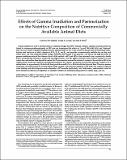| dc.contributor.author | Caulfield, Catherine D. | |
| dc.contributor.author | Kelly, John P. | |
| dc.date.accessioned | 2015-04-28T09:27:54Z | |
| dc.date.available | 2015-04-28T09:27:54Z | |
| dc.date.issued | 2008 | |
| dc.identifier.citation | Caulfield, CD,Cassidy, JP,Kelly, JP (2008) 'Effects of Gamma Irradiation and Pasteurization on the Nutritive Composition of Commercially Available Animal Diets'. Journal Of The American Association For Laboratory Animal Science, 47 :61-66. | en_US |
| dc.identifier.uri | http://hdl.handle.net/10379/4941 | |
| dc.description.abstract | Gamma radiation is used to sterilize diets for specific pathogen-free (SPF) animals. Because a gamma-irradiated diet was linked to leukoencephalomyelopathy in SPF cats, we investigated the effects of 'typical' (28.9-34.3 kGy) and 'high-end' (38.4-48.7 kGy) doses of gamma irradiation and of pasteurization (at 107 degrees C for 15 min) on the amounts of fat; protein; carbohydrate (and taurine in cat diet); vitamins A, E, B, B-1, B-2, and B-12; and peroxide in commercially available dry cat, dog, and rodent diets. The only treatment-related changes occurred with vitamin A and peroxide. The typical and high-end doses of gamma irradiation reduced the vitamin A level of the cat diet to 42% and 30% of the untreated value, respectively-levels below recommended allowances for growth and reproduction. Only the higher irradiation dose reduced vitamin A in the rodent diet, and neither dose altered the canine diet. Pasteurization reduced the vitamin A content of the cat diet to 50% of its original level, which was within the recommended level for this species. Irradiation increased the peroxide content of all 3 animal diets: by approximately 11-fold with the typical dose and by 14- to 25-fold with the high-end dose. Therefore gamma irradiation can have profound, selective effects on the vitamin A and peroxide contents of dry diets, and caution is advised when feeding such diets long-term and exclusively to SPF animals, particularly cats. Furthermore, pasteurization (with its fewer deleterious effects) may represent an alternative method of decontaminating diets for rodents, dogs, and cats. | en_US |
| dc.language.iso | en | en_US |
| dc.relation.ispartof | Journal Of The American Association For Laboratory Animal Science | en |
| dc.rights | Attribution-NonCommercial-NoDerivs 3.0 Ireland | |
| dc.rights.uri | https://creativecommons.org/licenses/by-nc-nd/3.0/ie/ | |
| dc.subject | VITAMIN-A-DEFICIENCY | en_US |
| dc.subject | LIPID PEROXIDE FORMATION | en_US |
| dc.subject | IONIZING-RADIATION | en_US |
| dc.subject | HYPOVITAMINOSIS-A | en_US |
| dc.subject | PRESSURE | en_US |
| dc.subject | STORAGE | en_US |
| dc.subject | CATTLE | en_US |
| dc.subject | CATS | en_US |
| dc.subject | FOOD | en_US |
| dc.title | Effects of Gamma Irradiation and Pasteurization on the Nutritive Composition of Commercially Available Animal Diets | en_US |
| dc.type | Article | en_US |
| dc.date.updated | 2015-03-13T17:32:43Z | |
| dc.description.peer-reviewed | peer-reviewed | |
| dc.contributor.funder | |~| | |
| dc.internal.rssid | 1334685 | |
| dc.local.contact | John Kelly, Dept. Of Pharmacology, & Therapeutics, Experimental Medicine Building, Nui Galway. 3268 Email: john.kelly@nuigalway.ie | |
| dc.local.copyrightchecked | Yes | |
| dc.local.version | PUBLISHED | |
| nui.item.downloads | 313 | |


